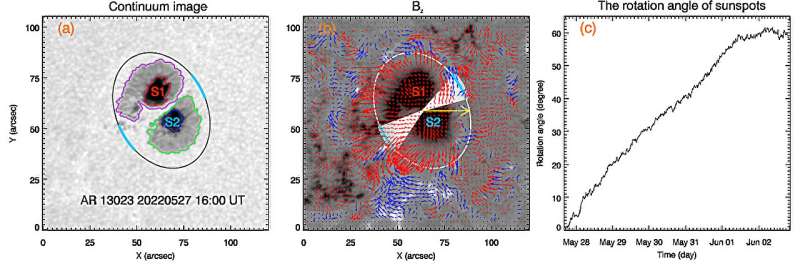January 30, 2024 feature
This article has been reviewed according to Science X's editorial process and policies. Editors have highlighted the following attributes while ensuring the content's credibility:
fact-checked
peer-reviewed publication
trusted source
proofread
Decay of sunspot pair elucidates properties of nearby moving magnetic features

Scientists studying sunspots have found important clues about magnetic features in their decay that will help understand the evolution and real origin of these mysterious magnetic phenomena. The findings are published in The Astrophysical Journal.
Understanding sunspots is crucial to understanding the solar cycle, the approximately 11-year periodic change that changes the sun's energy output and the frequency and intensity of flares it sends into space that can negatively influence satellites and electrical networks on Earth. (The solar "cycle" can range from eight to 14 years in length.)
Sunspots look rather simple from a distance but are complex areas where light from the sun is trapped by twisted magnetic fields. They are temporary regions of reduced temperature that appear as dark spots on the surface of the sun, where constricted magnetic flux suppresses convection that brings the inner heat of the sun to the surface. A sunspot is about the size of the Earth, and they often come in pairs.
Sunspot decay is also not well understood. The central umbra of a sunspot is dark and has the strongest magnetic fields; the surrounding penumbra, which may surround multiple sunspots, is brighter (but still darker than the sun) and is composed of elongated regions called penumbral filaments.
Full-fledged sunspots are surrounded by granular regions of convection, and these can form supergranules called moat cells, mostly nonmagnetic annular regions. The moat cells extend 10 to 20 million meters beyond the boundary of the sunspot penumbra.
Within the moat cell is the moat flow, a slow, radially outward flow of plasma directed away from the sun's center, that is, away from the sunspot. Then within these motions are small, moving magnetic features (MMFs) that migrate away from the sunspot, and depend on magnetic fields in the sunspot's penumbra.
Scientists from China observed two adjacent sunspots for seven days in 2022, with data taken by the Helioseismic and Magnetic Imager on board the Solar Dynamics Observatory (launched in 2010) and focused on the relationship between the magnetic flux decay of the two sunspots and the transportation of the magnetic flux by MMFs. ("Magnetic flux" can be envisioned as the outflow or inflow of magnetic field lines through a bounded area.)
The sunspots rotated counterclockwise around one another by about 13 degrees per day for the first five days, then the rotation stopped. Determining the boundaries of the umbra and penumbras by changes in solar intensity relative to the mean of the solar quiet region, they observed horizontal velocity fields of the plasma, which in turn gave estimates of the magnetic flux of the MMFs.
The sunspots in the pair each decayed at a rate of roughly 15 million km2 per day, an area about the size of Antarctica. Correspondingly, the rate of decrease in magnetic flux through the sunspot is of order 1020 maxwells per day, where a maxwell (Mx) is the unit of magnetic flux, equal to one gauss per cm2. (The Earth's magnetic field, while variable, is about 0.2 to 0.6 gauss.)
Within this, MMFs, the small scale magnetic volumes that stream radially away from their sunspot, had a size about 2 arcseconds as seen from Earth, and move about 400 meters per second.
The relationship between the magnetic flux loss from a decaying sunspot and MMFs is still mysterious. But the quantitative parameters measured here establish that "the formation of moving magnetic features is dependent on penumbral magnetic fields," said Yang Peng and Zhike Xue by email, authors from, respectively, the Yunnan Observatory of the Chinese Academy of Sciences and the University of Chinese Academy of Sciences.
"Our results show that a large number of MMFs will also generate in the penumbra-free region, and the vertical MMFs (MMFs whose magnetic field is vertical) in this region has greatly increased compared to that around the penumbra, which is closely related to the naked umbra in the granule."
These observations suggest that those MMFs with vertical magnetic fields are tightly related to the sunspot disintegration, and most of the MMFs from the gap region between the two sunspots may originate directly from the sunspot umbra.
"The results provide possible clues for the real origin of MMFs," said Peng and Xue.
More information: Yang Peng et al, The Decay of Two Adjacent Sunspots Associated with Moving Magnetic Features, The Astrophysical Journal (2024). DOI: 10.3847/1538-4357/ad063e
Journal information: Astrophysical Journal
© 2024 Science X Network




















